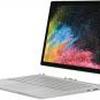Microsoft Surface Pro 6 and Surface Book 2 owners have been fighting a new issue. Ever since a firmware update was delivered from August 1 they suffer from a slower working processor. The cause is a problem with a feature that should prevent devices from overheating, and they throttle down towards 400 MHz.
Numerous user complaint that the ultra-portables are throttling towards 400 MHz. The throttle-lock appears to be caused by an Intel CPU flag called BD PROCHOT (bi-directional processor hot), which can be set by any peripheral, telling the processor to throttle down in order to decrease system temperature—a useful flag in cases where the CPU is operating within thermal limits, but other components tied to the CPU are running too hot, because of the demands placed on other components by processes on the CPU.
Determining what component is (erroneously) setting BD PROCHOT is difficult, with users of Surface Pro 6 systems noting that throttling disables after disconnecting from the Surface Dock or other AC adapter, while others point to third-party antivirus software as the culprit.
ThrottleStop is a third-party utility that (among other features) intercepts changes to MSR 0x1FC Bit 0, which controls the BD PROCHOT flag, preventing Surface devices from throttle-locking. If a Surface system genuinely is overheating, it will simply shut down to prevent damage.
"We are aware of some customers reporting a scenario with their Surface Books where CPU speeds are slowed," a Microsoft spokesperson states. "We are quickly working to address via a firmware update."
For a handful of users, the problem is gone after the Surface is removed from the dock or charger, but for others, even a reboot doesn't solve it.
Microsoft Surface devices clock back to 400 MHz after update

